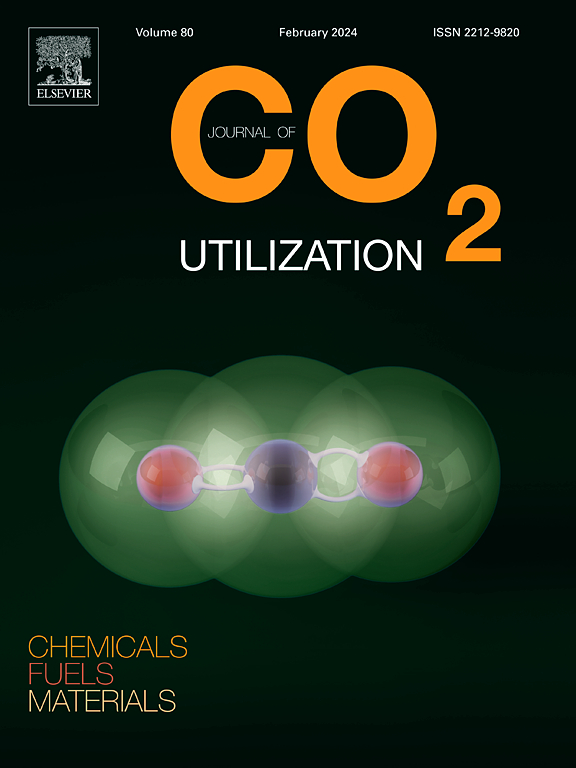Effect of photoactive carbon nitride and titanium dioxide features on HKUST-1 depositions and catalytic consequences during CO2 conversion in water
IF 7.2
2区 工程技术
Q1 CHEMISTRY, MULTIDISCIPLINARY
引用次数: 0
Abstract
“CO2 storage is one of the biggest challenges in controlling climate change. It can either be stored permanently or recycled into chemicals for which photoreduction of CO2 is a promising method by providing a way to enable conversion into high value chemicals with sunlight. Photoactive supports, such as carbon nitride or titanium dioxide catalyze this conversion and mesoporous materials can enhance substrate uptake by increasing surface area and adsorption. Metal-organic frameworks (MOF) deposition on such materials enables to increase substrate specificity and direct conversion into desired products. Since MOFs are affected by environmental factors, such as pH, temperature or co-ligands during their formation and interaction, structural differences in photoactive support will impact behavior and affect productivity of acetaldehyde and ethanol from CO2 and water within HKUST-1@support heterojunctions. This investigation compares morphological and photocatalytic effects of growing HKUST-1 on graphitic carbon nitride, mesoporous carbon nitride and TiO2. By adding MOF layers in a stepwise process, we investigate surface binding and interaction on each support in photoreduction of CO2 in a closed batch system under room temperature. Such methods allow us to study the effect of support-interactions on MOF growth and cross-reference to the observed photocatalytic activity. This leads to a shift towards ethanol productivity with selectivity of up to 63 % compared to acetaldehyde in the support itself, directing production towards specific products by adding MOF on photoactive support.”
光活性氮化碳和二氧化钛特性对HKUST-1沉积的影响及其在水中CO2转化的催化效果
“二氧化碳储存是控制气候变化的最大挑战之一。它既可以永久储存,也可以回收为化学品,其中二氧化碳的光还原是一种很有前途的方法,它提供了一种在阳光下转化为高价值化学品的方法。光活性载体,如氮化碳或二氧化钛催化这种转化,介孔材料可以通过增加表面积和吸附来增强底物的吸收。金属有机框架(MOF)沉积在这种材料上,可以增加衬底的特异性,并直接转化为所需的产品。由于mof在形成和相互作用过程中受到环境因素的影响,如pH、温度或共配体,因此光活性载体的结构差异将影响HKUST-1@support异质结中CO2和水对乙醛和乙醇的行为和生产力。本研究比较了HKUST-1生长对石墨氮化碳、介孔氮化碳和TiO2的形态和光催化效应。通过逐步添加MOF层,我们研究了室温下封闭批处理系统中CO2光还原过程中每个载体的表面结合和相互作用。这些方法使我们能够研究载体相互作用对MOF生长的影响,并与观察到的光催化活性进行交叉参考。与载体本身的乙醛相比,这导致了乙醇生产率的转变,选择性高达63% %,通过在光活性载体上添加MOF来指导特定产品的生产。”
本文章由计算机程序翻译,如有差异,请以英文原文为准。
求助全文
约1分钟内获得全文
求助全文
来源期刊

Journal of CO2 Utilization
CHEMISTRY, MULTIDISCIPLINARY-ENGINEERING, CHEMICAL
CiteScore
13.90
自引率
10.40%
发文量
406
审稿时长
2.8 months
期刊介绍:
The Journal of CO2 Utilization offers a single, multi-disciplinary, scholarly platform for the exchange of novel research in the field of CO2 re-use for scientists and engineers in chemicals, fuels and materials.
The emphasis is on the dissemination of leading-edge research from basic science to the development of new processes, technologies and applications.
The Journal of CO2 Utilization publishes original peer-reviewed research papers, reviews, and short communications, including experimental and theoretical work, and analytical models and simulations.
 求助内容:
求助内容: 应助结果提醒方式:
应助结果提醒方式:


